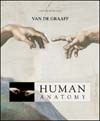 Internal Affairs (103.0K) Internal Affairs (103.0K)
Introduction to the Respiratory
System - Respiration refers not
only to ventilation (breathing), but also to the exchange of gases between
the atmosphere, the blood, and individual cells. Within cells, the metabolic
reactions that release energy are called cellular respiration.
- In order for the respiratory
system to function, the respiratory membranes must be moist, thin-walled,
highly vascular, and differentially permeable.
- The functions of the
respiratory system include gaseous exchange, sound production, assistance
in abdominal compression, and reflexive coughing and sneezing, and immune
response.
Conducting Passages - The nose is supported
by nasal bones and cartilages.
- The nasal epithelium
warms, moistens, and cleanses the inspired air.
- Olfactory epithelium
is associated with the sense of smell, and the nasal cavity acts as a resonating
chamber for the voice.
- The paranasal sinuses
are found in the maxillary, frontal, sphenoid, and ethmoid bones.
- These sinuses lighten
the skull and are lined with mucus-secreting goblet cells.
- Sinusitis is an inflammation
of one or more of the paranasal sinuses.
- The pharynx is a funnel-shaped
passageway that connects the oral and nasal cavities with the esophagus and
larynx.
- The nasopharynx,
connected by the auditory tubes to the middle-ear cavities, contains the
pharyngeal tonsils, or adenoids.
- The oropharynx is
the middle portion, extending from the soft palate to the level of the
hyoid bone; it contains the palatine and lingual tonsils.
- The laryngopharynx
extends from the hyoid bone to the larynx and esophagus.
- The larynx contains a
number of cartilages that keep the passageway to the trachea open during breathing
and closes the respiratory passageway during swallowing.
- The epiglottis is
a spoon-shaped structure that aids in closing the laryngeal opening, or
glottis, during swallowing.
- The vocal folds in
the larynx are controlled by intrinsic muscles and are used in sound production.
- The trachea is a rigid
tube, supported by incomplete rings of hyaline cartilage, that leads from
the larynx to the bronchial tree.
- The bronchial tree includes
a principal bronchus, which divides to produce lobar bronchi, segmental bronchi,
and bronchioles; the conducting division ends with the respiratory bronchioles,
which connect to the pulmonary alveoli.
Pulmonary Alveoli, Lungs,
and Pleurae - Pulmonary alveoli are
the functional units of the lungs, where gas exchange occurs; they are small,
thin-walled air sacs.
- The right and left lungs
are separated by the mediastinum. Each lung is divided into lobes and lobules.
- The right lung is
subdivided by two fissures into superior, middle, and inferior lobes.
- The left lung is
subdivided into a superior lobe and an inferior lobe by a single fissure.
- The lungs are covered
by visceral pleura, and the thoracic cavity is lined by a parietal pleura.
- The potential space
between these two pleural membranes is called the pleural cavity.
- The pleural membranes
compartmentalize each lung and exclude the structures located in the mediastinum.
Mechanics of Breathing
- Quiet (unforced) inspiration
is due to contraction of the diaphragm and certain intercostal muscles. Forced
inspiration is aided by the scalenes and the pectoralis minor and sternocleidomastoid
muscles.
- Quiet expiration is produced
by relaxation of the respiratory muscles and elastic recoil of the lungs and
thorax. Forced expiration is aided by certain intercostal muscles and the
abdominal muscles.
- Among the air volumes
exchanged in ventilation are tidal, inspiratory reserve, and expiratory reserve
volumes.
- Nonrespiratory air movements
are associated with coughing, sneezing, sighing, yawning, laughing, crying,
and hiccuping.
Regulation of Breathing
- Ventilation is directly
controlled by the rhythmicity center in the medulla oblongata, which in turn
is influenced by the pneumotaxic and apneustic centers in the pons.
- These brain stem areas
are affected by higher brain function and by sensory input from chemoreceptors.
- Central chemoreceptors
are located in the medulla oblongata; peripheral chemoreceptors are located
in the aortic and carotid bodies.
|



 2002 McGraw-Hill Higher Education
2002 McGraw-Hill Higher Education

 2002 McGraw-Hill Higher Education
2002 McGraw-Hill Higher Education